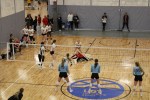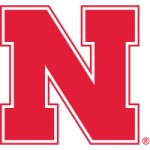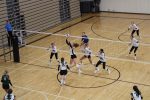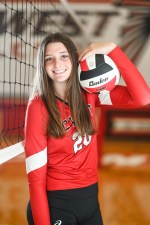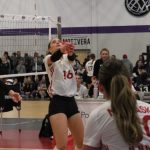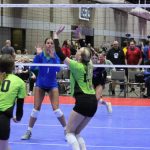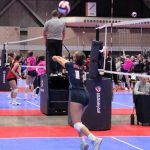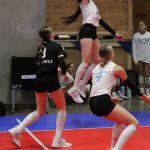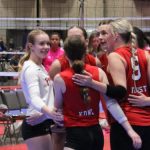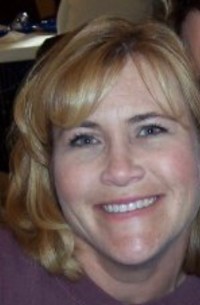Everyone Playing in Same Power League, Tryout System Overhaul and Other Changes We Would Like to See in Club Volleyball

As you get older, you tend to realize that nothing in life is stagnate. You’re either progressing or regressing; advancing or reversing; growing or dying.
It’s with that in mind, that we put forth some ideas about the club volleyball scene in Nebraska. It’s not that we necessarily see club volleyball in Nebraska heading in the wrong direction – but there are some clear opportunities for significant improvements that would be in the best interest of Nebraska volleyball in general.
Nebraska is a hotbed of volleyball talent. Volleyball recruiting expert Rich Kern has done research showing Nebraska has the second-highest ratio of Division I volleyball players in the nation on a per-capita basis. The 2014 graduating class in Nebraska, in fact, produced 17 players heading to Division I schools and each year roughly 100 high school seniors continue playing in college at various levels.
Yet, for the high number of top college recruits coming out of a small state you can pretty much count the number of top teams coming out of Nebraska on two hands. Nebraska had seven teams finish in the top 30 in the nation in Open division – four from Nebraska Juniors (181, 171, 161 & 151), two from Nebraska Elite (171 & 161) and one from Nebraska Impact (141).
You also have to tip your cap to River City Juniors 171 and Nebraska Elite 151 & 131 for each making it to gold brackets in lower-tier divisions. You can also put Nebraska ONE 111 in the mix as well for their performance in Minneapolis – finishing fifth in the only 11s division.
The question, though, is this: Should a talent-rich state like Nebraska produce more top-30 teams nationally? It’s a tough question, but we think at the least, the answer should be to try and improve on that number. So, here are some of our thoughts on raising the bar for club volleyball in Nebraska.
Contraction. Obviously, clubs in Nebraska are not simply going to close their doors. We realize that. It is worth wondering aloud, however, if Nebraska might have an excessive amount of clubs. Consider that there are approximately 1.8 million people in Nebraska and there are roughly 130 volleyball clubs. Now consider that the Minneapolis-St. Paul metropolitan area has roughly twice as many people with a population of roughly 3.5 million people and has approximately half the number of clubs – 66.
It’s great that there are so many clubs in Nebraska that provide opportunities for all aspiring players. It is very realistic to consider that this waters down the collective talent for each club’s best teams. This is not necessarily the case for Nebraska Juniors and Nebraska Elite – these two clubs have produced the largest quantity of Division I players in the state by a wide margin. It may however, be an issue for several other clubs.
As an example, VCNebraska in Lincoln and Nebraska Impact in Omaha have literally burst onto the club volleyball scene within the last handful of years and have become homes to some superb players, which more than five years ago, would have been at other clubs in Omaha and Lincoln. Some of these clubs that haven’t been around a long time are doing really good things. It will be interesting to see how they progress in the coming years.
Another point to consider is that club teams, in essence, should be like high school all-star teams. That’s not necessarily the case in Nebraska – and again you can point to the number of clubs and teams. In 2014 there were roughly 35 club teams from Omaha and Lincoln in the 17s and 18s divisions combined – which is comprised mostly of high school juniors and seniors. Consider that the Omaha and Lincoln areas only account for 35 Class A & B teams combined in the high school season. That ratio of club-to-high school teams doesn’t allow for the assembly of all-star teams. It in essence simply means the talent is redistributed, not consolidated.
As mentioned earlier, we don’t advocate there being fewer clubs, but when talking about what might be holding back Nebraska club volleyball from having more high-rankings teams, the number of clubs is certainly a conversation point.
Clubs need to put their top teams in Open divisions. Growth doesn’t happen within your comfort zone. The large and major clubs in Nebraska should have their top teams competing in Open divisions of major tournaments – and that includes qualifier tournaments.
Several of the top teams from the largest clubs compete in the Open division in the Asics President’s Day Tournament in Omaha. So, why not do the same in the USAV regional qualifiers? A big reason, we believe, is because of a misplaced emphasis on qualifying for nationals as opposed to placing high at nationals.
The theory of playing in divisions lower than Open at qualifiers to enhance your chances of earning a bid to nationals is both shortsighted and counter productive. When clubs do that, it’s comparable to a schoolteacher dumbing down curriculum and tests to help students earn better grades to help boost their GPA cosmetically. Would you really want a teacher to do that, as opposed to challenging students, pushing them academically and better preparing them for what lies ahead in college and beyond?
It all boils down to what each volleyball club has as its true mission. Is the purpose of the club to train and develop players while pushing them beyond what they are comfortable with in order to make them the best that they can be? Or is the mission of the volleyball club to shuffle players through the system while trying to get as many medals and trophies as possible for their display cases and to list on their website?
We have mentioned in earlier posts that any volleyball team can enter into the AAU National Championships in Orlando in any division they would like without needing to qualify. So, if it is important for clubs and teams to have that “Nationals experience” there is a guaranteed option out there. It is fair to wonder aloud that if a club refuses to explore all options available to its teams and players, is the club more worried about itself or its players.
As parents, you likely invest anywhere from $1,500 to $4,000-plus in a club volleyball season between fees, entry fees to tournaments, travel costs, etc. If you’re going to make that large of a financial commitment, don’t you want your athlete to get maximum exposure, play maximum competition and get the maximum development? If you play in Open division competition in large tournaments, that’s exactly what you get. When you drop down to lower divisions, you get significantly less.
If you consider yourself one of the top clubs in what is one of the most talent-rich volleyball states in the country, and you’re not putting your top team in each age division up against the best competition possible, you are short-changing your players. Club volleyball should be about development and getting your players maximum exposure.
Nebraska ONE, Nebraska Elite, Nebraska Impact and Premier need to put all of their top teams in the JVA Power League. There is absolutely no reason why this shouldn’t happen. As we’ve covered in other posts, JVA-exclusive teams are not allowed to compete in USAV competitions. Nothing, however, prevents USAV clubs from competing in JVA events.
As mentioned in the earlier point about the need for teams to challenge themselves and play the best competition available, getting all the large clubs in Nebraska in the same power league would benefit everyone. Nebraska Juniors, River City Juniors, VCNebraska and teams from some smaller clubs in Nebraska already compete in the Power League. So does Kairos from Sioux Falls – which puts out some outstanding teams.
The leaders of all the Nebraska clubs may not see eye-to-eye on many things and there are plenty of grudges within the group to go around. But, at some point, olive branches need to be exchanged to accomplish something that is so blatantly beneficial to all parties. The truth is that there needs to be added competition in the Power League. In addition, there needs to be added competition for USAV teams in the Great Plains. The fact that Nebraska has roughly eight large clubs and they don’t all play each other during the course of a club season is, well, ridiculous and counter-productive in a state that exudes volleyball talent and competition opportunities.
Consider that in the 16s age division, Premier 16 Gold went undefeated in Great Plains competition, which looks really impressive on the surface. However, consider that during the Great Plains season, Premier 16 Gold never played a team that finished the season ranked higher than #7 in our final rankings. Somehow, inexplicably, Nebraska Elite 16 Stealth (which finished #2 in the rankings) and Premier 16 Gold never played in a Great Plains weekend tournament. How is that possible?
The Nebraska Juniors 161 team finished 11th in the Open division at AAU Nationals and Nebraska Elite 16 Stealth finished 25th in the same tournament. Premier 16 Gold went undefeated in Great Plains play. Those three teams are separated by, like, 40 miles together and they were three of the better teams in the nation. How ridiculous is it that you can have three teams that good that close to each other that played each other a combined ZERO times? Those teams playing each other would have helped make each of them better. Put those three teams in a Power League together and everyone wins.
You put all the top teams from the top clubs in the same Power League and everyone wins. Joining the Power League would not impact a team’s ability to play in typical Great Plains weekend tournaments – it would simply replace two or three of them on the schedule. The Power League isn’t some weird, complicated thing – it’s simply a series of three weekend tournaments – one in Omaha, one in Lincoln and one in Sioux Falls. Playing in those locations isn’t a travel inconvenience and only requires one night of staying in a hotel on the Sioux Falls weekend.
One doesn’t need to look far to see examples of where blending USAV teams and a JVA Power League works. The Northern Lights JVA Power League in the Twin Cities is obviously the league administered by Northern Lights. By the way, Northern Lights just hosted the USAV National Championships. Being involved in both seems to work out well for them, especially considering how well Northern Lights teams did in both the AAU and USAV National Championships. How well did Northern Lights do? Its top teams combined for three National Championships and a total of nine top-10 finishes in Open division play between AAU and USAV.
The Tour of Texas JVA Power League has teams from clubs such as Skyline, Madfrogs, Tejas, Victory, AVA, TAV and Houston Juniors – among others – playing against each other in the same league. Again, it seems like those clubs help make each other better by playing against one another as much as possible.
This needs to happen. There is no reason for it to not happen.
Get rid of single day mass tryouts. If it walks like collusion and talks like collusion, well ……. I think you get the point. We all know the drill. All the clubs put tryouts on the same day at the same time, basically locking volleyball players into one club. This is one-sided and does not take into consideration the best interest of the player, and their parents who are investing in their child.
In the business world, what if all companies only interviewed one day a year for new jobs and all at the same time? Well, you would get a lot of unhappy people, a lot of politicking and posturing, backroom deals and tons of stress. Sound familiar? Instead of volleyball players and families being empowered with the ability to find the right fit for them, many players and families are forced to accept situations they may not like because they have no other choices. The way the current tryout system works make going to the DMV feel like a vacation.
So, how do you solve the problem? Encourage open recruitment. Encourage teams to sign players during an early signing period of July 15-30 and/or a late signing period from Dec. 1-15. Let clubs have multiple tryout “sessions” on different days and times during those periods. Let clubs and coaches assemble their team in any way by any means they want. Let clubs and coaches fight over the best players. Let clubs offer reduced fees to certain players if they would like. Frankly, top teams at the biggest clubs should be invite-only or put together without much of a tryout.Those teams should be loaded. Those teams should be special. They should be treated different.
Having signing periods, similar to that in college, during these dates also eliminates having older players show up for tryouts early in the morning the day after the state tournament. It’s common for players to drag themselves into a club tryout in the early-morning hours of a Sunday after having just competed for a state title 12 hours earlier. Really? We really need to put players through that? Let the top players sign with the club they want before high school even starts. In some regions in Texas they have their tryouts in July. These changes would make for a better system with better overall outcomes.
At the end of the day, clubs should be able to assemble their teams however they want without regulation. And, most importantly, volleyball players of all ages should be allowed the opportunity to tryout at different clubs as opposed to the system in place now. In the current system, players are treated like cattle being herded. In a state like Nebraska where we value our children, you would hope we could put a better system in place.
Great Plains and/or USAV need to create a tiered membership plan. So, we’ve talked about how the major USAV top teams should play in the JVA Power League. Similarly, it would be a huge improvement if the Great Plains Region and/or USAV created a tiered membership plan which would allow clubs (such as Nebraska Juniors, River City Juniors, etc.) to pay a reduced fee and be eligible for playing in Great Plains weekend tournaments.
Perhaps a mid-tier membership at half the price would make clubs eligible for weekend tournaments within region but would not allow for access to the regional qualifiers, bid tournaments or USAV Nationals. It also would not make mid-level members subject to USAV bylaws.
Such an option might appeal to JVA-only clubs. It could mean increased entries (and entry fees) into Great Plains tournaments hosted by clubs such as Nebraska ONE, Nebraska Elite, etc., and increased competition. Again, it is borderline ridiculous for the best teams in Nebraska to not play each other and make each other better.
USAV and/or Great Plains could even create a “temporary membership” which would grant a club or team access to a Great Plains weekend tournament and then expire. Have an interested club pay the usual tournament entry fee plus a $10-per-player/coach fee for the temporary membership for the weekend. That might mean that a JVA club team would have to pay close to $300 for a Gold tournament as opposed to $175 – but it may still be cheaper for that JVA club than going to an out-of-state tournament.
There are simple solutions out there such as this, which could put an end to “The Great Divide” in Nebraska club volleyball.
Finally, there is one rule we would like to see put in place in club volleyball ranks. Put an end to club coaches getting paid to give lessons to players who will be trying out for their team. It’s a common practice that Tony Soprano might appreciate, but it needs to come to an end. At best, this is highly unethical and sleazy.
As an example, coach John Smith is named as the coach for Club X’s top 14s teams in August. Right now, John Smith would stand to make some pretty good money from parents lining up for their daughters – who are going to be trying out for the 14s – to have private lessons with him. And this happens A LOT. Parents will easily pay between $40-$75+ per hour for lessons to get their daughter in front of the coach they are trying to impress. In just a matter of a few weeks, a parent can easily put $400-$600 into the pocket of the coach who will determine their daughter’s fate at tryouts (we understand that the coach must pay for expenses such as court rental, etc.).
Larger clubs have plenty of coaches, instructors, etc., that there should be no issue finding someone to provide lessons for a player OTHER than the coach who will be picking players in that age division. The practice of parents being able to put cash in the pocket of a coach who is picking teams their daughter is eligible for is not something people with Midwestern values should stand for. Again, if it walks like it’s unethical and talks like it’s unethical, then it’s unethical. If that is an acceptable practice at the club where your daughter plays, it should be a concern.
Make no mistake about it; there are a lot of great things in the club volleyball world in Nebraska. There are many outstanding clubs and literally hundreds of amazing coaches out there who put a lot of passion and hard work into making youth volleyball in Nebraska what it is. However, you can never be complacent nor content staying within your comfort zone. We’ve touched on a few areas where there is a chance to significant improvement. And if you aren’t improving then you’re – well – you’re declining and nobody wants to see that happen.




